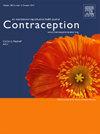三年内多种方法的实际避孕失败率:她的盐湖避孕倡议的发现--一项前瞻性队列研究
IF 2.3
2区 医学
Q1 OBSTETRICS & GYNECOLOGY
引用次数: 0
摘要
目标 "HER 盐湖避孕倡议 "在犹他州盐湖县的四家计划生育诊所提供了长达三年的免费避孕选择。方法在 36 个月内的 9 个时间点收集调查数据,以评估用户体验,包括使用皮下埋植、铜宫内节育器、荷尔蒙宫内节育器、药片、环、注射和非荷尔蒙行为方法的个人的转换、中止和怀孕体验。我们计算了 1 年、2 年和 3 年的避孕失败发生率和 95% 的置信区间,并根据报告的每种避孕方法持续使用者的人年计算了累计失败发生率。激素宫内节育器的累计失败率最低(发生率 (IR),0.006/人-年;95% CI,0.004-0.011),其次是皮下埋植避孕法(IR,0.008/人-年;95% CI,0.005-0.016)、铜宫内节育器(IR,0.011/人-年;95% CI,0.006-0.019)、注射避孕法(IR,0.结论现实世界中的三年失败率很少公布。与目前公布的信息相比,HER 参与者获得了他们喜欢的方法,并报告了较低的各种方法的典型使用失败率。虽然参与研究可能会影响行为,但在讨论避孕药具的长期有效性时,优先考虑患者偏好的避孕措施所提供的数据会增加重要的背景信息。我们的研究结果为致力于提供全套避孕选择的避孕措施提供了令人鼓舞的数据,并支持所有避孕方法的有效性。本文章由计算机程序翻译,如有差异,请以英文原文为准。
REAL-WORLD CONTRACEPTIVE FAILURE RATES OF MULTIPLE METHODS OVER THREE YEARS: FINDINGS FROM THE HER SALT LAKE CONTRACEPTIVE INITIATIVE — A PROSPECTIVE COHORT STUDY
Objectives
The HER Salt Lake Contraceptive Initiative provided no-cost contraceptive options for up to three years at four family planning clinics in Salt Lake County, UT. In this analysis, we assess real-world contraceptive failure rates as reported by HER Salt Lake participants.
Methods
Survey data were collected at nine time points over 36 months to assess user experiences, including switching, discontinuation, and pregnancy experiences among individuals using the implant, copper IUD, hormonal IUD, pills, ring, injectable, and nonhormonal behavioral methods. We calculated incidence ratios and 95% confidence intervals for contraceptive failures at 1, 2, and 3 years, as well as cumulative incidence failure rates based on reported person-years among continuers for each of these methods.
Results
Among 4,278 individuals, there were 91 unintended pregnancies that occurred while contracepting. Hormonal IUDs had the overall lowest cumulative incidence failure rate (incidence rate (IR), 0.006/person-year; 95% CI, 0.004–0.011), followed by the implant (IR, 0.008/person-year; 95% CI, 0.005–0.016), copper IUD (IR, 0.011/person-year; 95% CI, 0.006–0.019), injectable (IR, 0.014/person-year; 95% CI, 0.006–0.025), ring (IR, 0.019/person-year; 95% CI, 0.007–0.044), pills (IR, 0.022/person-year; 95% CI, 0.016–0.031) and nonhormonal behavioral methods (IR, 0.05/person-year; 95% CI, 0.016–0.148).
Conclusions
Three-year failure rates in real-world settings are rarely published. The HER participants received their preferred methods and reported lower typical-use failure rates across methods compared to currently published information. While participation in research may influence behaviors, data from contraceptive initiatives that prioritize patient preference add important context when discussing contraceptive effectiveness over time. Our findings provide encouraging data for contraceptive access initiatives committed to offering the full range of contraceptive options and support the effectiveness of all methods.
求助全文
通过发布文献求助,成功后即可免费获取论文全文。
去求助
来源期刊

Contraception
医学-妇产科学
CiteScore
4.70
自引率
17.20%
发文量
211
审稿时长
69 days
期刊介绍:
Contraception has an open access mirror journal Contraception: X, sharing the same aims and scope, editorial team, submission system and rigorous peer review.
The journal Contraception wishes to advance reproductive health through the rapid publication of the best and most interesting new scholarship regarding contraception and related fields such as abortion. The journal welcomes manuscripts from investigators working in the laboratory, clinical and social sciences, as well as public health and health professions education.
 求助内容:
求助内容: 应助结果提醒方式:
应助结果提醒方式:


